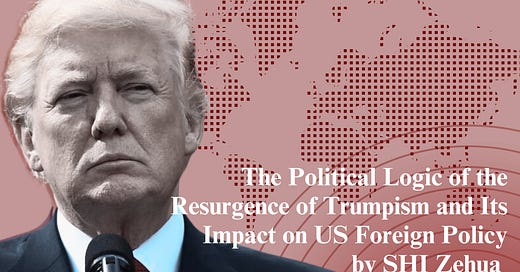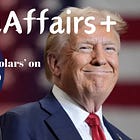The Political Logic of the Resurgence of Trumpism and Its Impact on US Foreign Policy by SHI Zehua
In Trump 2.0, Trumpism will still have great impact on American foreign policy.
Welcome to the 28th edition of our weekly newsletter! I am SUN Chenghao, a fellow with the Center for International Security and Strategy (CISS) at Tsinghua University, Council Member of The Chinese Association of American Studies and a visiting scholar at the Paul Tsai China Center of Yale Law School (fall 2024).
ChinAffairs+ is a weekly newsletter that shares Chinese academic articles focused on topics such as China’s foreign policy, China-U.S. relations, China-European relations, and more. This newsletter was co-founded by me and my research assistant, ZHANG Xueyu.
Through carefully selected Chinese academic articles, we aim to provide you with key insights into the issues that China’s academic and strategic communities are focused on. We will highlight why each article matters and the most important takeaways. Questions or criticisms may be addressed to sunchenghao@tsinghua.edu.cn
Today, we have selected an article written by SHI Zehua, which focuses on the political logic of the resurgence of trumpism and its impact on US foreign policy.
Summary
Trumpism is usually understood as a complex of the ideology, political style, political movements, and policy behaviors of Trump and his followers, with typical characteristics of right-wing populist ideology. In the past decade, against the backdrop of the continued and deep economic and social crisis in the United States, Trumpism has undergone multiple transitions from ideology to organization and then to action strategies, from its initial rise to its resurgence.
Ideologically, Trumpism is a complex of American right-wing populism and modern conservatism, and its resurgence means that the right-wing populist ideology is infiltrating and eroding traditional conservative politics. Organizationally, the resurgence of Trumpism is manifested in the emergence of a new cabinet, several new organizations and think tanks with a right-wing populist style, marking the overall shift of the organizational model of the right-wing populist political elite from the populist “individual hero” path to the bureaucratic group politics path.
From the perspective of behavioral characteristics, the resurgence of Trumpism heralds the gradual transformation of the right-wing populist action model from loose and decentralized social resentment politics to a rational decision-making model with clear goals. The irreconcilable deep-seated contradictions between the various factions of the American right-wing camp and the collective irrational psychological state of Trump and the right-wing populists make this multi-dimensional transformation process difficult. The U.S. domestic and foreign policies will move towards a more determined and extreme right-wing populist path.
Why it matters
The international community has witnessed significant geopolitical shifts. Recently, Trump has had heated discussion with Ukraine president, which is perceived as a concession to Russian interests and the desire to satisfy American interests. This move is merely an indicator of a broader pattern of Trump administration’s actions that appear to undermine traditional alliances and democratic principles.
The resurgence of “Trumpism” has profound domestic and international implications. On the one hand, it signifies a shift towards policies that prioritize nationalism, potentially at the expense of multilateral cooperation with its allies. On the other hand, this ideology influences the U.S.’s engagement with global institutions and its stance on international conflicts, thereby affecting the global balance of power.
At the same time, the rise of Trumpism can be traced back to the economic, cultural, and political trends within the United States in recent years. Additionally, it is worth noting that under the wave of economic globalization’s decline, the “Trump phenomenon” does not appear to be an isolated case. Across the Atlantic, many European countries are also facing a resurgence of right-wing ideologies, which may have a profound impact on the future global situation.
Understanding the ideological underpinnings and strategic objectives of “Trumpism” is crucial for policymakers and analysts. Based on the perspectives of the author, we can better anticipate future strategies of the U.S.
Key Points
The Theoretical Foundation of the Resurgence of Trumpism
Trumpism is a political movement shaped by both right-wing populism and conservatism, leaning toward the former. Its resurgence is driven by the successful integration of these two ideologies, reshaping the Republican Party around populist issues.
Conservatism
The core of “Trumpism” is rooted in old conservatism from the 1980s-1990s, which opposes neoconservatism’s centralized governance and interventionist foreign policy. Instead, it promotes Christian ethics, republican self-governance, and non-interventionism while preserving regional cultures, such as the religious traditions of the Southern “Sun Belt” and the commercial values of the Midwestern “Heartland”. Influenced by Alexis de Tocqueville, old conservatives believe true democracy arises from local institutions and self-reliance, warning that excessive government centralization threatens its very foundation.
Right-Wing Populism
The main component of Trumpism is Right-wing populism whose influence on “Trumpism” is evident in the “Rust Belt” culture that emerged among the white working class in the Midwest and Great Lakes regions during America’s deindustrialization. Right-wing populism is a “thin-centered ideology”, lacking depth, intellectual backing, and theoretical rigor. Before Trump, it was a conservative appendage. But after he took office, the rise of right-wing populism transformed embedded cultural conservatism into the party's discourse and methods, reshaping its political identity.
The Convergence of Conservatism and Right-Wing Populism
On moral order, right-wing populists align with conservatives, believing a meaningful life must be “based on religious recognition” and that restoring society requires rediscovering the nation’s founding virtues. However, they argue today’s elites betray these principles, turning America into a country that no longer represents its majority. To reclaim it, they seek to awaken the “angry majority”, expose conspiracies, and eliminate threats.
On socioeconomic order, they support conservative ideals—linking liberty with property, prioritizing opportunity over outcome, and opposing government micromanagement. However, they feel betrayed by big corporations and global capital.
On domestic political order, they share conservatives' preference for limited government and strong local institutions but take distrust further, seeing the “deep state” as the root of decline. Breaking elite-government ties is more critical than balancing budgets. Leaders are judged by action—those who fail to deliver are removed.
On international political order, they embrace “prudent realism”, believing America must prioritize self-preservation. Unlike old conservatives, they push extreme actions: securing borders, punishing immigrant crime, and defending American identity. Security has no limits, and as a “victim,” America is justified in demanding compensation from the world.
Trumpism’s Resurgence: From Grassroots Movement to Established Ideology
Formation of a Right-Wing Populist Cabinet: Trump’s second-term cabinet selections are more strategic, prioritizing loyalty and drawing from populist-leaning intellectuals. Unlike his first term, which saw high turnover in key positions, he has now chosen figures aligned with his ideology. For example, Susie Wiles, a longtime Trump loyalist, has been named Chief of Staff, ensuring stability and efficiency within his administration. Other key appointments reflect a focus on serving the white middle class, including Lori Chavez-DeRemer as Labor Secretary, Kristi Noem as Secretary of Homeland Security, and billionaire Scott Bessent as Treasury Secretary, despite criticism from some conservative factions.
Building a Right-Wing Political Network: Organizations like “Save America” and the Conservative Partnership Institute (CPI) support Trump’s movement by funding legal battles and coordinating political strategies. “Save America” allocated 10% of its funds to legal defense, spending over $60 million on Trump and his allies. CPI, led by former Senator Jim DeMint, serves as a networking hub for conservative policymakers. Additionally, a coalition of 20 right-wing groups, including the Center for American Renewal (CAR) and the State Freedom Caucus Network (SFCN), further amplifies the movement’s agenda. Within Congress, the Freedom Caucus remains Trump’s strongest legislative ally, significantly influencing Republican leadership.
Establishing Trumpism Think Tank: The Heritage Foundation, historically a leading conservative think tank, continues to play a role, but Trump has distanced himself from its new 2025 policy blueprint. Instead, the America First Policy Institute (AFPI), founded by former Trump administration officials, has gained prominence. AFPI promotes Trump’s key policies, including economic protectionism, deregulation, strict immigration enforcement, and national security. The institute prepared nearly 300 executive orders in anticipation of a Trump presidency and aligned closely with his 2024 campaign. Following the election, AFPI leader Linda McMahon was appointed co-chair of the official transition team.
Trumpism’s Resurgent Policy Agenda: A Shift from Elite Decision-Making to Populist Priorities
Stronger Borders: Hardline Immigration Policies
Trump’s immigration agenda focused on border security, mass deportations, and restricting legal immigration. This shift responded to conservative frustrations with past Republican compromises, which sought to balance Latino voter outreach with border enforcement. Trump’s approach included $15 billion for border walls, stricter visa controls, and prioritizing low-skill seasonal workers over skilled foreign professionals. By 2018, 54% of Trump supporters associated MAGA with border security. Before the 2024 election, over 80% of Republicans favored border expansion and military enforcement, while Latino voters increasingly supported Trump, prioritizing economic concerns over immigration policy.
Economic Strength: Populist Protectionism over Traditional Republicanism
Since Reagan, Republican economic policies have prioritized corporate and wealthy interests, often aligning with libertarian conservatism. Trumpism challenged this model, advocating for tariffs, energy independence, and manufacturing growth. Initially, only 14% of Trump’s 2016 campaign funds came from corporate donors, reflecting his outsider status. Despite libertarian opposition to his trade policies, Trump reframed tariffs as negotiation tactics rather than strict policy goals. By 2024, Trump secured 69% of his campaign donations from major corporate donors, showing increased acceptance of his economic agenda. After the election, he appointed Robert F. Kennedy Jr. as Health Secretary and aligned with Elon Musk and Silicon Valley conservatives on immigration policy.
Government Reform: Targeting the “Deep State”
Trumpism views the federal bureaucracy as an entrenched elite (“deep state”) obstructing populist governance. While conservatives favor limited government, populists see bureaucratic resistance as a major problem. Trump pledged to dismantle bureaucratic overreach, appointing Vivek Ramaswamy and Elon Musk to lead a new “Government Efficiency Department” aimed at slashing regulations and reducing waste—potentially saving $2 trillion, according to Musk. Trump’s approach demonizes political opposition, creating a model of a “purified society” that rewards loyalists and eliminates dissenters.
Social and Cultural Policies: Appealing to the Conservative Base
Support among white evangelicals and conservative Catholics remained strong despite Trump’s controversies, with 67% of white evangelicals, 51% of white Catholics, and 45% of Hispanic Protestants viewing him favorably. His policies focus on religious freedom, gun rights, and social conservatism, advocating for local education governance, harsher crime penalties, and less government intervention in healthcare. However, Trump’s main challenge lies in navigating institutional resistance from Congress, the courts, and military-industrial interests controlling federal spending.
The Foreign Policy Impact of Trumpism: From “America First” to “Chaos First”
Strategic Shift in U.S. Foreign Policy: Under Trump, U.S. foreign policy continued its strategic retreat. Since Reagan, Republican presidents have sought a balance between conservative realism and factional interests. Bush-era neoconservatives pushed for aggressive interventions, but economic crises and mounting war debts shifted the party toward “America First”. Trumpism views globalization as detrimental to U.S. interests, advocating withdrawal from multilateral agreements, renegotiation of unfavorable trade deals, tariff increases, and stricter border controls. The goal is a foreign policy centered on unilateralism, extreme pressure tactics, and bold negotiations while avoiding deep entanglements.
Destablizing the Policy Implementation Process: Trump’s foreign policy, marked by impulsiveness and loyalty-driven appointments, limits institutional oversight. His reliance on social media and stock market trends bypasses traditional advisory channels. Despite efforts to formalize decision-making under John Kelly, Trump’s inner circle operated with minimal constraints. For his second term, he appointed Michael Waltz as National Security Advisor and Marco Rubio as Secretary of State, aiming to avoid past missteps. However, issues persist—Trump’s unpredictability, his cabinet’s neoconservative leanings, and a direct-to-public approach continue to fuel volatility in foreign policy.
Power Dynamics Altered by Reshuffled Interest Groups: The Trump administration disrupted traditional lobbying structures, initially restricting former officials from engaging in lobbying. However, the president’s inner circle frequently engaged in political deal-making, hosting interest group events at Trump properties. In his second term, right-wing interest groups, including those from the manufacturing and energy sectors, advocate for protectionist policies. While big tech and defense industries anticipate favorable policies, Trump’s self-serving diplomatic approach risks undermining long-term business interests, contradicting traditional free-market principles.
Conclusion
Over nearly a decade, the political logic behind "Trumpism" has become clear: addressing the concerns of grassroots conservatives—such as illegal immigration, wealth disparity, and middle-class decline—through a unique governance approach that blends populism with conservative ideology. In battles against two Democratic administrations, Trump, alongside right-wing intellectuals, emerging political action groups, and congressional allies, ousted the GOP establishment and secured a sweeping 2024 victory. This highlights the internal and external “rationality” of Trumpism, which has transformed the GOP into a working-class party and pushed the U.S. toward economic nationalism. However, Trump’s dominance faces challenges, including divisions between libertarians and populists over wealth distribution and tensions between religious conservatives and populists on social issues. His authoritarian governance may further undermine social stability, while an inward-looking foreign policy could deepen America’s global isolation. Despite its success, right-wing populism’s “thin-centered” nature prevents it from fully replacing traditional conservatism as the dominant U.S. ideology.
About the Author
Shi Zehua史泽华:Dr. Shi worked in research administration for several years before briefly serving as a journalist and editor at Xinhua News Agency following his master’s degree. Since 2006, he has been affiliated with Beijing Foreign Studies University, where he currently serves as an Associate Professor at the School of International Relations, Assistant Dean, and Chair of the Department of Political Science. He is also a Senior Research Fellow at the Public Diplomacy Research Center. Beyond academia, he contributes as a columnist for The Beijing News’ “Great Power Perspectives” section and as a guest commentator for Phoenix News and Tencent News. In 2014, he was a visiting scholar at the Korbel School of International Studies at the University of Denver. His research interests focus on U.S. studies and the politics of divided societies.
About Publication
The Chinese version of the article was published in Contemporary International Relations(《现代国际关系》), a policy-oriented research journal, which has been published by China Institutes of Contemporary International Relations since 1990. In the beginning, it was established as a regular monthly publication and in 2006 converted to a bi-monthly journal. A primary purpose of its journal is to present the views of CICIR researchers on international politics and international relations. The journal’s scope of publication also includes papers by scholars and researchers from other institutes in China and from around the world. It covers analysis of changes in international relations and prominent world events and publishes papers on international relation theory studies.











